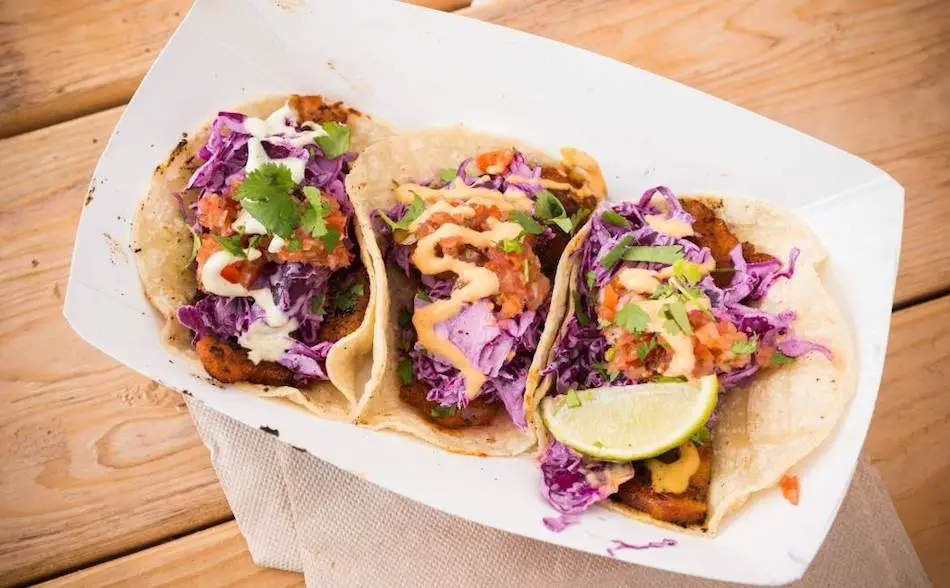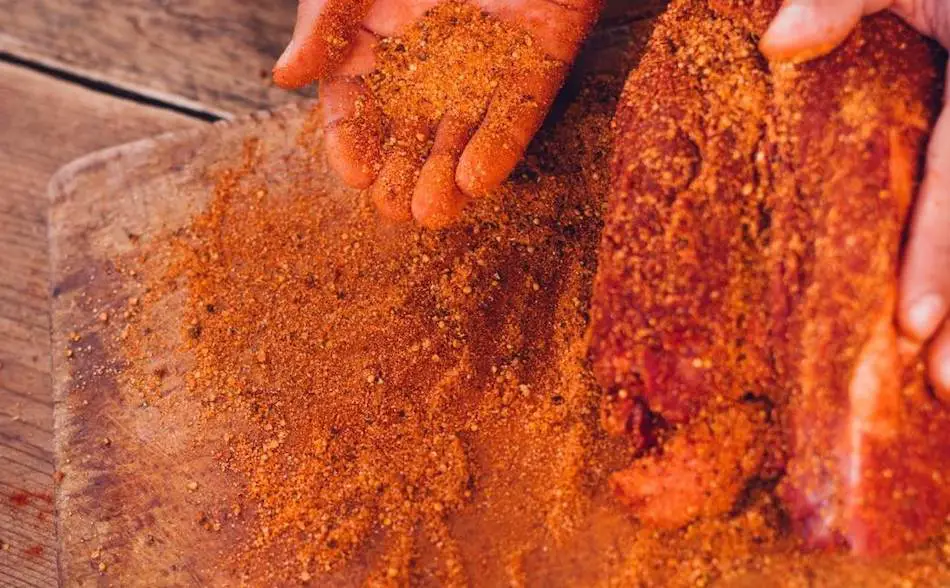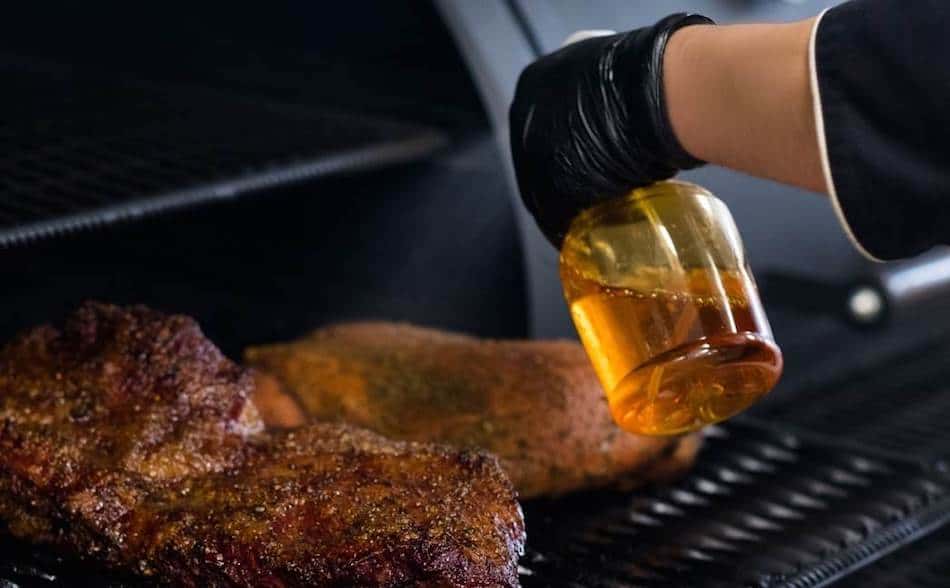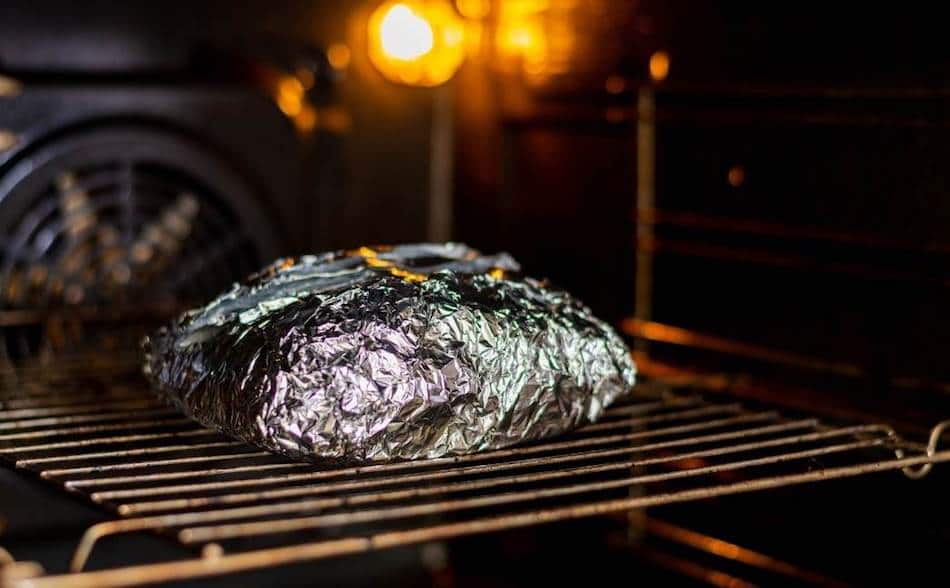
Brisket and tacos are a match made in heaven. The rich, smoky flavor of freshly smoked brisket pairs perfectly with the warm and comforting flavors of traditional tacos. The combination of textures and flavors is truly irresistible. This recipe is perfect for those who are looking for a new way to enjoy brisket. The key to making this dish a success is to use freshly smoked brisket, as the flavors and tenderness will be at their peak. The brisket should be shredded or thinly sliced and topped with your favorite taco toppings such as diced onions, cilantro, and a squeeze of lime juice.
Smoked Brisket Tacos

Smoked brisket, shredded and served as tacos.
Ingredients
- 1 tbsp of chili powder
- 1/2 tsp of red pepper flakes
- 1/4 tsp of cayenne pepper
- 1 tbsp paprika
- 1 tsp chipotle pepper
- 1 tsp of oregano
- 1 tbsp of cumin powder
- 1 tbsp of granulated garlic
- Tortillas
- Avocados
- Lime juice
- Coriander
- Salt and pepper.
- Cilantro
- Red onion
- Cheese
- Tomatos
- Jalapenos
- Sour cream
Instructions
Mexican Rub
Combine the chili powder, red pepper flakes, cayenne pepper, paprika, chipotle pepper, oregano, cumin powder and granulated garlic.
Brisket Preparation
1. Trim the brisket, leaving 1/4 inch fat on top. Remove silver skin underneath.
2. Brush brisket in olive oil.
3. Apply the Mexican rub to the brisket. Cover the entire brisket in a thick layer of the seasoning.
4. Set your smoker to 225°F
5. If using a charcoal smoker, throw some hickory, pecan, oak or any other smoking wood on the fire.
6. Place the brisket on the grill fat side down.
7. Leave for 3 hours
8. Once the bark is hard, spritz every hour with apple cider vinegar.
9. Once the bark is set and the internal meat temperature is above 160°F, wrap the brisket in foil.
10. Insert a meat thermometer into the brisket.
11. Continue cooking until the brisket reaches an internal temperature of 203°F.
12. Let the brisket rest for 1 hour.
13. Shred the brisket and serve in tortillas with avocados, lime juice, coriander, salt and pepper., cilantro, red onion, cheese, tomatos, jalapenos, sour cream.
Nutrition Information:
Amount Per Serving: Calories: 240
Traditional Mexican Tacos: Tips and Tricks
Here are some tips and tricks for making traditional Mexican tacos:
- Use traditional Mexican ingredients: To make traditional Mexican tacos, it’s important to use traditional Mexican ingredients such as corn tortillas, cilantro, lime, and a variety of Mexican chilies.
- Use the right kind of meat: For traditional Mexican tacos, you should use meats such as beef, pork, chicken or fish. These meats are typically marinated with a combination of chilies, spices, and citrus juice.
- Avoid using cheese: Traditional Mexican tacos do not typically include cheese, so avoid using it as a topping.
- Use the right kind of cooking method: Traditionally, tacos are made on a comal, which is a type of griddle that is used to cook tortillas and other Mexican dishes. Using this method will give your tacos a traditional flavor and texture.
- Be mindful of the toppings you use: To make traditional Mexican tacos, it’s important to use toppings such as diced onions, cilantro, and salsa.
- Use fresh ingredients: To make traditional Mexican tacos, it’s important to use fresh ingredients to get the most authentic flavor.
- Be mindful of the proportion of ingredients: The proportions of ingredients are important in traditional Mexican tacos. The tortilla should be the base and the toppings should be in proportion to the size of the tortilla.
- Keep it simple: The key to making traditional Mexican tacos is to keep it simple and let the flavors of the ingredients shine.
Keep in mind that traditional Mexican cuisine is diverse and there are many different variations of tacos, and the above tips are general guidelines, as you can find many different ways of making traditional tacos depending on the region and the cooks.
| Traditional Taco Ingredients | Quantity |
|---|---|
| Protein (beef, chicken, pork, fish or tofu) | 1 lb |
| Diced onions | 1/2 cup |
| Diced tomatoes | 1/2 cup |
| Chopped cilantro | 1/4 cup |
| Vegetable oil | 1 tbsp |
| Corn tortillas | 8-12 |
| Salt | to taste |
| Pepper | to taste |
| Lime wedges | for garnish |
| Instructions for Traditional Tacos |
|---|
| 1. Heat the oil in a skillet over medium-high heat. Add the protein and cook for about 5-7 minutes or until fully cooked. |
| 2. Add the onions and tomatoes to the skillet, and cook for an additional 2-3 minutes. |
| 3. Season the mixture with salt and pepper to taste. |
| 4. Add the cilantro and stir to combine. |
| 5. Heat the tortillas in a skillet or on a comal (a traditional Mexican griddle) for about 30 seconds per side. |
| 6. Assemble the tacos by spooning the protein mixture onto each tortilla and top with diced onions and chopped cilantro. |
| 7. Serve with lime wedges on the side. |
American vs. Traditional Mexican Tacos
Traditional Mexican tacos and American versions of tacos have some similarities, but there are also some significant differences between the two.
One of the main differences is the type of meat used. Traditional Mexican tacos typically use meats such as beef, pork, chicken or fish that are marinated with a combination of chilies, spices, and citrus juice. Americanized tacos, on the other hand, often use ground beef or chicken that is heavily seasoned with cumin, chili powder, and other spices.
Another difference is the tortilla. Traditional Mexican tacos use corn tortillas while Americanized tacos often use flour tortillas. Corn tortillas are smaller and thinner than flour tortillas and also have a different texture and taste.
Toppings are also different, traditional Mexican tacos are typically topped with diced onions, cilantro, lime and a variety of Mexican chilies. Americanized tacos often include cheese, lettuce, sour cream, and other toppings that are not typically found in traditional Mexican tacos.
In traditional Mexican cuisine, tacos are often served as a street food, they are meant to be simple, and the flavors are focused on the meat and a few toppings. Americanized tacos are often more elaborate, with a variety of ingredients and toppings.
The Tex-Mex Fusion
The fusion between American BBQ and Mexican food is a blend of two distinct culinary traditions that have come together to create a unique and delicious style of cooking.
One of the main ways that American BBQ and Mexican food have fused is through the use of BBQ techniques, such as smoking and grilling, on traditional Mexican meats and ingredients. For example, a popular dish is the BBQ brisket taco, where brisket, a traditional BBQ meat, is cooked using BBQ methods and then served in a corn tortilla with traditional Mexican toppings like cilantro, diced onions and lime. Another example of this fusion is BBQ pulled pork with a Mexican-inspired rub or marinade, or even BBQ chicken tacos with a Mexican-style salsa.
Another way that the two cuisines have fused is through the use of traditional Mexican flavors and seasonings in American BBQ dishes. For example, a BBQ sauce with a Mexican twist, made with ingredients like chipotle peppers, cumin, and cilantro, or a BBQ rub made with a combination of traditional Mexican spices like cumin, chili powder, and oregano.
The fusion of American BBQ and Mexican food has also led to the creation of a new type of cuisine, Tex-Mex cuisine which is a fusion of Texan and Mexican cuisine. This cuisine is characterized by dishes such as chili con carne, fajitas, and nachos, which have become popular in the United States, and it’s a staple of Tex-Mex cuisine.
The fusion of American BBQ and Mexican food is a reflection of the diverse cultural influences in the United States, and it has led to the creation of a unique and delicious style of cooking that is enjoyed by many.
Brisket Needs Time
Smoking a brisket can be a time-consuming process, but the end result is worth the wait. If you have a large brisket, it will take anywhere from 8 to 12 hours or longer, depending on the size of the cut. The key to making a tender and flavorful brisket is to cook it low and slow. This allows the connective tissue to break down, resulting in a tender and juicy meat.
The “low and slow” method is the best way to cook a brisket. This involves cooking the brisket at a low temperature (around 225-250°F) for several hours. The cooking time will vary depend on the size of the brisket, but a general rule of thumb is to cook it for about 1 hour per pound of meat.
One important thing to keep in mind while cooking brisket is that it is a very tough cut of meat, so it needs to be cooked until all the connective tissue has broken down. If the brisket is not cooked long enough, it will be tough and chewy, and all the hard work will be wasted. To ensure that the brisket is cooked to perfection, it is best to use a meat thermometer to check the internal temperature. The internal temperature should be around 190-205°F when it’s done.
“Brisket Uses – Here’s 8 Things You Can Do”
The Rub and Seasoning
The major difference between a regular smoked brisket and a brisket for tacos is going to be the seasoning. You could use a taco seasoning that you buy from the store. However, I would recommend making your own because you want to control the salt and the spice.
The rub is one of the most important steps when smoking brisket because that only does it add an enormous amount of flavor, and also helps with the formation of the bark; arguably the best part of the smoked brisket. You can use your usual brisket rub, or Aaron Franklin style salt and pepper rub, or you can use a Mexican seasoning.
Salt and Pepper
First, cover your brisket with a decent layer of salt and pepper. Or you can mix it in with your Mexican seasoning where you can put one tablespoon of salt and a tablespoon of pepper. I always season the meat with salt and pepper separately. This will give the salt a few extra hours to work its way into the meat.
Use a nice coarse black pepper, like a 16-mesh, but this is optional. Morton’s kosher salt is preferred by many pitmasters, but use whatever’s on hand. However, try not to use table salt. It’s too fine and contains iodine etc.
Mexican Brisket Rub
For this step, you can use a Mexican seasoning that you buy from the store. If you go this route, just make sure you check the salt content because you don’t want to double salt your brisket. I recommend making your own, because it’s super easy.
| Ingredient | Quantity |
|---|---|
| Chili powder | 1 tbsp |
| Red pepper flakes | 1/2 tsp |
| Cayenne pepper | 1/4 tsp |
| Paprika | 1 tbsp |
| Chipotle pepper | 1 tsp |
| Oregano | 1 tsp |
| Cumin powder | 1 tbsp |
| Granulated garlic | 1 tbsp |
| Onion powder | 1 tsp |
| Kosher salt | 1 tbsp |
| Ground black pepper | 1 tbsp |
Prepping The Brisket
- Leave one quarter of an inch of fat on your brisket, because this won’t render and you want some fat to protect the meat.
- Remove the silver skin on the underside of the brisket.
- Prior to applying the rub, use a binder such as olive oil or yellow mustard so the seasoning will stick to the meat. This is optional, however I find I have less patches on my bark if I use a binder.
- Apply the salt and pepper then your Mexican seasoning. Make sure you cover all parts of the brisket with the rub.

Fire Up Your Smoker
- Preheat your smoker, so it’s running between 225° F and 250° F. You will want to hold it there for the entire cook.
- If you are using a charcoal smoker, throw on a couple of chunks of hickory or your favorite smoking wood. If you’re using a pellet grill, it doesn’t really matter what type of wood pellets you use, just be careful with mesquite, as it may overpower the brisket and make it taste bitter.
- Once you get some nice smoke rolling, it’s time to add the brisket.
- Place the brisket on the grill, with the fat side facing down, if the heat source is coming from below. Otherwise, place the brisket fat side up. If your fire is coming from below, I prefer fat side down because it will shield the brisket from the heat and help prevent charring and prevent them from drying out.
- Insert a thermometer probe into the brisket, I use a TP20, the best-selling thermometer on Amazon and only cost me about $50.
- Leave the brisket alone for about 3 or 4 hours. Don’t open the lid, don’t spritz, just let the brisket absorb smoke. One of the biggest mistakes people can make is they will constantly open the lid. This will destabilize your smoker.
Develop a Bark
During this first stage of the cook, we are trying to develop a nice crispy bark on the outer layer of the brisket. The bark is a combination of dehydrated meat, fat, smoke, and the seasoning. One of the best features of the smoke brisket is a nice crispy bark. If you are shredding part of your brisket for tacos, it’s nice to have a mix of soft tender meat and a little of crunch from the bark.
“Brisket Sliders – The Easiest Way To Build Perfect Mini Buns”
Spritzing
Spritzing the brisket is an important step. Use a spray bottle and fill it with apple cider vinegar or apple juice. After about 4 hours, the brisket should have some nice color and the seasonings should be set to the meat. You don’t want to spritz the meat until the seasoning has stuck, otherwise all your rub will just wash off, and you’ll have a patchy bark.
Once the rub has set, begin spritzing the brisket every 45 minutes to an hour. You will notice the edges of the brisket may char, so give the edges a good spray. Spritzing has several benefits. Not only will it stop the meat from burning, it will also slow down the cook. When smoking brisket, we want to keep the meat at a low temperature for as long as possible because we need to buy time. This cut of meat has a lot of connective tissue, and the only way it will melt and turn to gelatin is with time at low temperatures.

Wrapping
Wrapping is important because it will help cook the brisket faster, and will prevent the meat from drying out. You can use aluminium foil, or would your paper to wrap your brisket. Paper will allow the brisket to breathe and you’ll end up with a crispier bark. However, foil is suitable but It will create a little more steam and you’ll find the bark is softer. For more on the paper vs foil debate, check out this article.
Judging when to wrap a brisket is something that comes with experience. There are signs you should look out for. Once the bark is cracking, this is a sign that the brisket is nearly ready. By the stage, the brisket should look like a black meteorite. This is also another good sign. The internal temperature should be between about 150° F to 160° F or thereabouts.
Wrap the brisket in two layers of foil or paper. Insert your thermometer probe back into the brisket, and place it back in smoker, or close your smoker down and bring the brisket inside and finish it in the oven. It will make no difference at this stage of the cook, because now the brisket is wrapped, it’s going to take on no more flavor. Now, it’s all about getting the brisket to the done temperature.

Done Temperature
The ideal temperature to smoke brisket is 203° F. This seems to be the internal temperature that most barbecue pitmasters will call time on their briskets. However, you shouldn’t go by temperature alone, but learn to look for some other signs.
The most important thing to learn is how to test for tenderness. It should feel like sticking a toothpick into a stick of butter. Take your thermometer probe, and probe the thick and thin areas of the brisket. If you notice it feels as though you are inserting the thermometer into a stick of butter, then you have reached the perfect tenderness. If there feels like there’s some resistance, then it needs a little longer.
Resting
Resting can make a break your brisket. Never skip this step and just shred or slice your brisket immediately after pulling it from your smoker. During the cook, the muscles tighten and push out moisture.
When you remove the brisket from the smoker, those muscles are still tight and will still continue pushing out moisture. By allowing the muscles to relax, the brisket will reabsorb some of that moisture. Allow about 1 hour to rest a brisket, or place it into holding where it can remain hot for several hours.
To place the brisket into holding, take a dry cooler, wrap the brisket in a towel, and leave the foil or paper wrapping intact. Keep the thermometer probe inserted into the meat, so you can track the temperature while it’s cooling down.
As long as the brisket doesn’t go belong as safe eating temperature, then it’s can remain in the cooler for about 4 or 5 hours. I’ve had briskets and dry cooler for longer than 4 hours and when I go to slice it, it’s still red hot. I’ve seen Pitmasters hold a brisket in a cooler for seven or eight hours.
Slicing and Shredding
The best way to prepare brisket for tacos is to slice and shred. Brisket has two muscles, a point and a flat. These two muscles are separated by a seam, which is easy to separate with a knife. Cut through the seam, and separate the flat from the point. When making tacos, I like to shred the point, and slice the flat. However, you can do it whatever way you prefer.
Only slice or shred what you need. The moment you slice or shred the brisket, all the moisture is just going to escape and won’t get back in there. If you’ve got leftovers, they are much better to be stored as a piece rather than slices.
Brisket Time Planner
Since smoking a brisket is a marathon effort, it’s a good idea to plan your cook.
| Brisket Total Cook Time | Start Time | Begin Spritzing | Wrap Brisket | Finish in Oven | Done Time (203°F) | Holding Time In Dry Cooler (1-4 hours) |
| 12 hours | 6pm | 9pm | 12am | 12am | 6am | Between 7am – 10am |
| 15 hours | 5pm | 8pm | 11pm | 11pm | 8am | Between 9am – 12pm |
| 18 hours | 2pm | 5pm | 8pm | 8pm | 8am | Between 9am- 12pm |
My Favorite Brisket Tools
Thanks for checking out this article. I hope you learned a few things. Here are some of my favorite tools I use when smoking brisket that may be useful to you. These are affiliate links, so if you decide to purchase any of these products, I’ll earn a commission. But in all honesty, these are the tools I recommend to my family and friends who are just starting out.
Meat Injector: Injecting meat is a great way to take your barbecue to the next level and help you make competition-style brisket. An injector is the only way you will be able to get flavor and moisture into the middle of the meat. The Beast Injector is a stainless steel injector that is sturdy and affordable. Check the latest price on Amazon here.
Brisket Marinade: The best injection solution on the market is the Butcher BBQ Brisket Injection. This marinade is used in competitions and is made by World Barbecue Champion pitmaster, Dave Bouska. You can find the marinade on Amazon here.
Butcher Paper: Wrapping brisket in butcher paper has become a huge trend in barbeque thanks to Aaron Franklin. Wrapping your brisket in paper will give you a nice brisket bark. However, you can’t just use any old paper, it has to be unwaxed, food grade paper. You can find it on Amazon here.
Brisket Rub: These days I make my own rub when possible, but I always have a few pre-made rubs for when I’m running low. Barbecue guru Malcom Reed produces Killer Hogs, one of the best brisket rubs I’ve found over the years. Another great rub is Slap Yo Daddy, made by brisket master and multiple World Barbecue Champion, Harry Soo.
Meat Thermometer: There are dozens of fancy thermometers on the market, but I still use my trusty TP20. For around $50, I have a high-quality meat thermometer with two probes, and can track the temperature of my smoker with one probe, and my meat with the other probe. The ThermoPro TP20 is an Amazon Best Seller because it’s the easiest thermometer to operate, is durable, highly accurate, and comes with pre-programmed meat settings.
Instant Read Thermometer: Arguably, the second most important tool you need is a fast and accurate instant-read thermometer. These tools play an important role in the latter stages of the cook when the meat needs regular checking in multiple areas. I use the ThermoPro TP19 because it can do everything a ThermaPen can do, but for a fraction of the cost. You can check out the TP19 on Amazon here.
Advanced Thermometer and Automatic Temperature Controller: Once you’re ready to take things seriously, the FireBoard 2 Drive is a six-channel Bluetooth/Wi-Fi thermometer that can monitor up to 6 pieces of meat, control and graph your cook sessions on your smartphone, and attaches to an an automatic blower that will convert your charcoal smoker to a set-and-forget. This is one of the most advanced meat thermometers on the market. You can check it out on the FireBoard website here.
